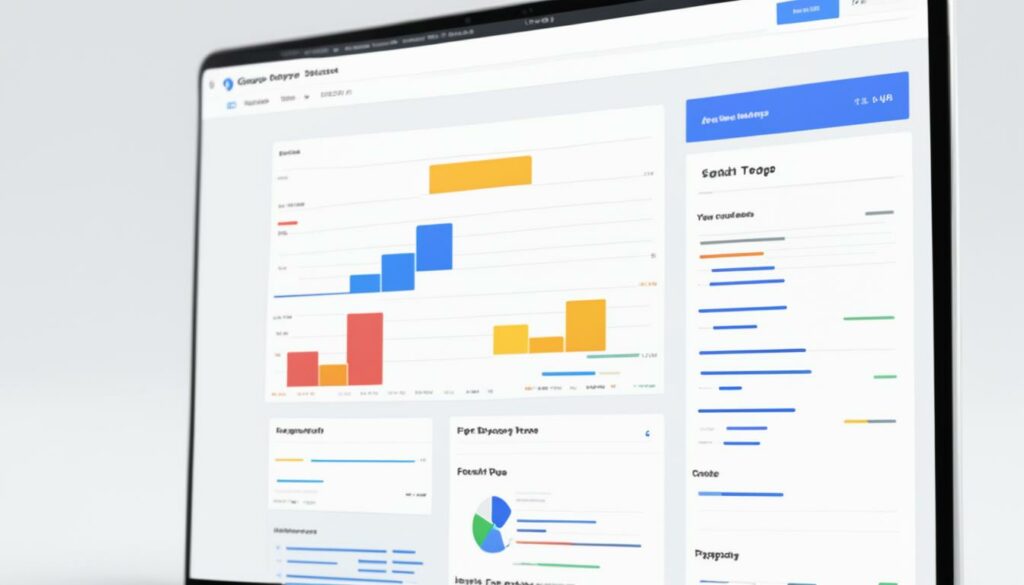Welcome to the beginners’ guide to scaling WordPress efficiently! As an online business owner, you want to ensure that your WordPress website can handle high traffic without compromising performance. Slow-loading or inaccessible websites can negatively impact your site ranking and harm your business reputation. In this guide, we will discuss the impact of high traffic on page speed and provide you with strategies to maintain optimal performance.
Key Takeaways:
- Implementing on-page SEO for WordPress can improve your website’s visibility on search engines.
- Optimizing WordPress content for SEO is essential for improving website rankings.
- Utilizing SEO plugins for WordPress can enhance your SEO strategies.
- Regularly optimizing your WordPress site for search engines can result in better performance and increased traffic.
- Following a WordPress SEO checklist can help you ensure that your website is fully optimized.
How Scalable is WordPress?
WordPress is a versatile platform that allows you to create a wide range of websites, from simple portfolios to large eCommerce stores. However, when it comes to handling high web traffic, WordPress websites require careful consideration and optimization to ensure optimal performance.
Scaling WordPress involves addressing various aspects that impact the platform’s ability to handle increased traffic. Let’s explore some key factors to consider:
Database Loading
The database plays a crucial role in storing and retrieving website data. As web traffic increases, the database can become a bottleneck, causing delays in loading content. Optimizing your database queries, indexing tables, and using caching mechanisms can help alleviate this issue and improve overall performance.
Dealing with a Large Number of Visitors
When your WordPress website experiences a surge in visitors, it’s essential to ensure that your server can handle the load efficiently. Implementing performance optimizations such as content caching, load balancing, and utilizing a content delivery network (CDN) can help distribute the traffic and provide a seamless experience to users.
Website Caching
Caching is a crucial technique that significantly improves website performance and scalability. By temporarily storing static versions of your website pages, caching reduces the server load and improves response times for subsequent requests. Utilizing caching plugins like WP Super Cache or W3 Total Cache can help optimize your WordPress site for high traffic scenarios.
Media Optimization
Images, videos, and other media elements contribute to the overall size of your web pages. Optimizing media files by compressing them, leveraging lazy loading techniques, and utilizing responsive images ensures faster loading times, resulting in a more scalable website.
Coding Architecture
The structure and quality of your WordPress theme and plugins can significantly impact your website’s scalability. Efficient coding practices, using lightweight themes, and regularly updating plugins can improve the efficiency of your site’s codebase and enhance its ability to handle high web traffic.
By considering these aspects and implementing strategic optimizations, you can enhance the scalability of your WordPress website and effectively manage high web traffic. In the next section, we will delve deeper into loading speed optimization.
Loading Speed Optimization
When it comes to website optimization, loading speed plays a crucial role. A slow-loading website not only frustrates visitors but also negatively impacts user experience and increases bounce rates. To ensure your WordPress site delivers a seamless browsing experience, it’s essential to optimize its loading speed. This section will explore effective strategies to improve WordPress loading speed and enhance website performance.
Assessing Website Performance
Before diving into optimization strategies, it’s important to assess your website’s current performance. Tools like Google PageSpeed Insight provide valuable insights into your website’s speed and performance. By analyzing the results, you can identify specific areas that require improvement.
Website Optimization Strategies
- Optimize Images: Images often contribute significantly to page weight and can slow down website loading speed. Compressing and resizing images, as well as caching them, can help reduce loading time. Remember to use descriptive alt tags to enhance SEO.
- Minify CSS and JavaScript: Minifying CSS and JavaScript files involves removing unnecessary characters and spaces, reducing their file size, and improving loading speed.
- Utilize Caching: Implementing caching mechanisms can significantly speed up your WordPress site. Caching plugins like WP Super Cache or W3 Total Cache store static versions of your web pages, reducing database queries and improving overall performance.
- Optimize Database: Regularly optimize and clean up your WordPress database to enhance website performance. Removing unnecessary data, such as post revisions and spam comments, can improve loading speed.
- Choose a Fast Hosting Provider: The hosting provider you choose for your WordPress site plays a vital role in loading speed. Consider investing in a reliable and fast hosting solution to ensure optimal website performance.
- Enable GZIP Compression: Enabling GZIP compression reduces the size of files sent from your server to visitors’ browsers, improving loading speed.
- Minimize External HTTP Requests: External HTTP requests, such as loading scripts and stylesheets from external sources, can impact loading speed. Minimize these requests by combining and reducing unnecessary scripts and stylesheets.
By implementing these optimization strategies, you can accelerate your WordPress website’s loading speed, providing a better user experience and improving your site’s overall performance.

Optimizing your WordPress site’s loading speed is essential for improving user experience and reducing bounce rates. Slow-loading websites can negatively impact your site’s performance and deter potential visitors. By assessing your website’s performance, optimizing images, utilizing caching mechanisms, and implementing other effective strategies, you can enhance your WordPress site’s loading speed and provide a seamless browsing experience.
Caching for Improved Performance
In order to achieve faster website performance and handle high traffic efficiently, caching plays a critical role. By storing and serving cached versions of web pages, you can significantly reduce the server load and enhance your website’s performance. In this section, we will explore different caching options for WordPress, including popular caching plugins and effective website caching strategies.
Caching Plugins for WordPress
When it comes to WordPress caching, there are several powerful plugins available that can streamline the caching process and enhance your website’s performance. Some of the notable caching plugins for WordPress include:
- LiteSpeed Cache: This plugin offers comprehensive caching solutions and optimization features, resulting in faster page load times and improved website performance.
- WP Super Cache: Known for its simplicity and user-friendly interface, WP Super Cache generates static HTML files that are served to your site visitors, reducing the server load and improving performance.
- W3 Total Cache: Offering a wide range of caching options, W3 Total Cache is a popular choice among WordPress users. It optimizes website performance by leveraging various caching methods and techniques.
By utilizing these caching plugins, you can enhance your website’s speed and performance, ensuring a smooth user experience even during peak traffic periods.
Website Caching Strategies
In addition to caching plugins, implementing effective caching strategies can further optimize your website’s performance. Here are some key strategies to consider:
- Object Caching: By implementing object caching, you can store frequently accessed data in memory, reducing the time it takes to retrieve information from the database and enhancing overall performance.
- Clearing WordPress Site Cache: Deleting outdated cached files on a regular basis ensures your visitors receive the most up-to-date content and prevents potential issues caused by outdated or conflicting cached data.
Implementing a combination of caching plugins and effective caching strategies will enable your website to handle high traffic while delivering fast and efficient user experiences.
| Plugin | Key Features |
|---|---|
| LiteSpeed Cache | Comprehensive caching solutions and optimization features |
| WP Super Cache | Generates static HTML files for faster page load times |
| W3 Total Cache | Offers a wide range of caching options and optimization techniques |

Ensuring Website Security
Securing your WordPress site from cyber-attacks is crucial, especially when scaling your website. By implementing proper security measures, you can protect your site and data from potential threats. Here are some important steps to ensure website security:
- Regularly update WordPress, themes, and plugins: Keeping your WordPress core, themes, and plugins up to date is vital to prevent vulnerabilities that hackers may exploit. Regular updates often include security patches and bug fixes, ensuring your site stays protected.
- Use strong login credentials: Creating unique and strong passwords for your WordPress admin accounts adds an extra layer of security. Additionally, consider implementing two-factor authentication (2FA) to further secure your login process.
- Install SSL certificates: Using SSL certificates helps encrypt the connection between your website and visitors’ browsers, ensuring secure communication. This is particularly important if you handle sensitive information like customer data or payment details.
- Remove unused themes and plugins: Unused themes and plugins can become potential entry points for attackers. It’s important to regularly review and delete any unnecessary themes or plugins that are not actively used on your site.
Furthermore, utilizing security plugins designed specifically for WordPress can greatly enhance your website’s security. One popular security plugin is Wordfence, which provides features such as firewalls, malware scanning, login security, and IP blocking.
“Ensuring the security of your WordPress website is crucial in protecting your business and user data from cyber-attacks. By regularly updating your WordPress installation, using strong login credentials, installing SSL certificates, and removing unused themes and plugins, you can significantly minimize the risk of security breaches.”
By prioritizing website security measures, you can safeguard your WordPress site and provide visitors with a safe browsing experience.
Recommended Security Plugins for WordPress
| Plugin Name | Description |
|---|---|
| Wordfence Security | A comprehensive security plugin offering firewall protection, malware scanning, and login security features. |
| Sucuri Security | An all-in-one website security solution that includes remote malware scanning, security audit, and blacklist monitoring. |
| iThemes Security | A security plugin that provides features like two-factor authentication, brute force protection, and database backups. |
Optimizing Image Usage
Images play a crucial role in enhancing the visual appeal of your website. However, if not optimized properly, they can contribute to slow page loading times and negatively impact user experience. To ensure optimal performance and handle high traffic efficiently, it is important to optimize the usage of images in WordPress.
One key aspect of image optimization is reducing image size. Large image files can significantly slow down a website. By compressing images without sacrificing quality, you can dramatically reduce their file size, leading to faster loading times. There are several WordPress plugins available, such as Smush and ShortPixel, that can automatically compress images upon uploading.
Resizing images is another effective strategy for optimizing their usage. Uploading excessively large images and then resizing them within the HTML source code can cause unnecessary bloat. Instead, resize images to the appropriate dimensions before uploading them to WordPress. This ensures that the images are displayed at the correct size, reducing unnecessary bandwidth usage.
Implementing caching for images is essential for improving website performance. By caching images, you can store them on the user’s device temporarily, enabling faster loading times upon subsequent visits. WordPress caching plugins like W3 Total Cache and WP Super Cache can help implement image caching effectively.
Clearing up your WordPress media library is also crucial for optimizing image usage. Over time, your media library can become cluttered with unused or duplicate images. By regularly clearing out these unnecessary files, you not only improve the organization of your media library but also reduce the overall size of your website, leading to improved performance.
Optimizing image usage in WordPress involves a combination of reducing image size, resizing images, caching images, and clearing up your media library. By implementing these strategies, you can significantly improve website performance, handle high traffic efficiently, and provide a seamless user experience.
Benefits of Optimizing Image Usage
- Improved page loading times
- Enhanced user experience
- Reduced bandwidth usage
- Optimal display of images
- Efficient handling of high web traffic

| Image Optimization Strategy | Benefits |
|---|---|
| Reducing image size | – Faster loading times – Reduced bandwidth usage |
| Resizing images | – Optimal display – Reduced bloat |
| Caching images | – Faster subsequent visits – Improved website performance |
| Clearing up media library | – Improved organization – Reduced website size |
Fixing Broken Links
Broken links can be detrimental to both user experience and website indexing on search engines. When visitors encounter broken links while navigating your WordPress website, they may become frustrated and leave, resulting in lost opportunities for engagement and conversions. Moreover, search engine crawlers may struggle to index your website properly, impacting your search engine rankings.
To ensure an error-free website and improve user experience, it is vital to fix broken links. One way to accomplish this is by utilizing a reliable broken link checker tool specifically designed for WordPress websites. These tools scan your website thoroughly, identifying any broken links and providing reports on their locations. By regularly using a broken link checker, you can identify and remove broken links promptly, minimizing any negative impact on user experience and search engine indexing.
“Using a broken link checker tool can save you time and effort by automating the process of identifying broken links. It’s a crucial step for maintaining a smooth website and enhancing user satisfaction.”
If you prefer a manual approach, you can review your website’s content and navigation links individually. Start by examining critical pages such as your homepage, main menu, and popular posts or pages. Click on every link and ensure it leads to the intended destination. If you encounter any broken links, either remove them or update them with the correct URLs.
Removing Broken Links
When removing broken links, it is essential to consider the impact on user experience and search engine optimization. For external broken links, consider replacing them with relevant and reliable alternatives to maintain a seamless user experience. However, for internal broken links, it is best to update them with working URLs or remove them if they are no longer relevant.
Taking the time to fix broken links not only enhances user experience but also improves your website’s indexing on search engines. Search engines prioritize websites with excellent user experience, and having a broken link-free website contributes to a positive user experience and boosts your chances of achieving higher search engine rankings.
To summarize, fixing broken links is crucial for maintaining a user-friendly website and improving website indexing on search engines. Whether you choose to use a broken link checker tool or review links manually, regularly addressing broken links will ensure that visitors have a seamless browsing experience and search engines can effectively index your website.
Broken Link Checker Tools for WordPress
| Tool Name | Key Features |
|---|---|
| Broken Link Checker | – Scans your entire website – Detects broken links in posts, pages, comments, and more – Provides detailed reports and notifications |
| Dr. Link Check | – Crawl your website for broken links – Checks images, CSS, and JavaScript files – Generates reports with broken link locations |
| WP Link Status | – Performs comprehensive link checks – Scans for broken links, redirects, and more – Offers an advanced interface for managing links |
Tracking and Analyzing Performance
When it comes to scaling your WordPress website efficiently, tracking and analyzing performance is a crucial step. By monitoring website performance, you can identify areas for improvement and stay alert to potential issues. Utilizing website analytics tools such as Google Analytics, Pingdom, or Site24x7 can provide valuable insights into your website’s overall performance.
With Google Analytics, you can dive deep into the metrics of your website, tracking user behavior, traffic sources, and engagement. This powerful tool allows you to understand how visitors interact with your site and make data-driven decisions to optimize its performance.
Pingdom offers real-time monitoring of your website’s uptime and response time. By setting up performance monitoring with Pingdom, you can receive alerts whenever your website experiences slowdowns or downtime. This proactive approach enables you to address potential issues promptly, ensuring a smooth user experience.
Site24x7 provides comprehensive website monitoring solutions, offering insights into various performance metrics, including website uptime, response time, and resource utilization. With automated checks and customizable alerts, you can set specific thresholds and receive notifications when certain performance metrics are exceeded.
“Tracking and analyzing website performance allows you to make informed decisions and optimize your WordPress site for high traffic. Use tools like Google Analytics, Pingdom, or Site24x7 to gain valuable insights and ensure your website operates at its best.”
By tracking and analyzing performance using these website analytics tools, you can effectively optimize your WordPress website for high traffic. Stay ahead of potential performance issues, improve user experience, and ensure that your website can handle the demands of scaling. Through continuous monitoring and data-driven decision-making, you can enhance your website’s performance and maintain it at peak efficiency.
Conclusion
Scaling your WordPress website efficiently is crucial to handle high web traffic and maintain optimal website performance. By implementing various website optimization strategies, you can ensure that your WordPress site is prepared to handle the demands of increased traffic.
Start by optimizing the loading speed of your website. Use tools like Google PageSpeed Insight to analyze its performance and make necessary improvements. Compressing images, leveraging caching techniques, and streamlining your website’s code can significantly improve loading times and enhance user experience.
Website security is another vital aspect to consider when scaling WordPress. Regularly update WordPress, themes, and plugins to protect your site from cyber-attacks. Utilize SSL certificates, strong login credentials, and security plugins like Wordfence to add additional layers of protection.
Ensure that your website has a robust infrastructure to handle high traffic by optimizing image usage and fixing broken links. Compress and cache images to reduce page weight and improve loading speed. Regularly check for broken links using tools like Broken Link Checker to maintain a seamless user experience and improve search engine indexing.
Lastly, tracking and analyzing your website’s performance with tools like Google Analytics, Pingdom, or Site24x7 is essential. Stay vigilant and proactive by monitoring performance metrics, identifying areas for improvement, and addressing potential issues promptly.
FAQ
Q: How do I optimize my WordPress website for search engines?
A: To optimize your WordPress website for search engines, you can follow these best practices:
– Use SEO-friendly permalinks
– Optimize your website’s meta tags
– Create high-quality and keyword-rich content
– Use SEO plugins like Yoast SEO or Rank Math
– Generate XML sitemaps
– Optimize website loading speed
Q: Can WordPress handle high web traffic?
A: Yes, WordPress is a versatile platform that can handle high web traffic. However, it requires proper optimization and scalability measures to handle a large number of visitors without compromising performance.
Q: How can I improve the loading speed of my WordPress site?
A: Here are some ways to optimize the loading speed of your WordPress site:
– Optimize image sizes and use a caching plugin
– Minimize the use of plugins and scripts
– Enable browser caching and Gzip compression
– Use a content delivery network (CDN)
Q: What are the best caching plugins for WordPress?
A: Some popular caching plugins for WordPress include LiteSpeed Cache, WP Super Cache, and W3 Total Cache. These plugins help improve website performance by storing and serving cached versions of web pages.
Q: How can I ensure the security of my WordPress website?
A: To ensure the security of your WordPress website, you can follow these steps:
– Keep WordPress, themes, and plugins up to date
– Use strong login credentials and avoid common usernames
– Install SSL certificates for secure data transfer
– Remove unused themes and plugins
– Utilize security plugins like Wordfence
Q: How can I optimize the usage of images on my WordPress site?
A: You can optimize the usage of images on your WordPress site by following these tips:
– Compress and resize images to reduce file size
– Use caching plugins to serve cached versions of images
– Clear up the WordPress media library and remove unused images
Q: How do broken links affect my WordPress website?
A: Broken links negatively impact user experience and can prevent search engines from properly indexing your website. It is important to regularly check for broken links using tools like Broken Link Checker and fix them promptly.
Q: What tools can I use to track and analyze my WordPress website’s performance?
A: Some popular tools for tracking and analyzing WordPress website performance include Google Analytics, Pingdom, and Site24x7. These tools provide valuable insights into website traffic, user behavior, and performance metrics.
Q: How do I scale my WordPress website to handle high traffic?
A: To scale your WordPress website, you can follow these strategies:
– Optimize loading speed and implement caching
– Ensure website security
– Optimize image usage and fix broken links
– Track and analyze website performance











